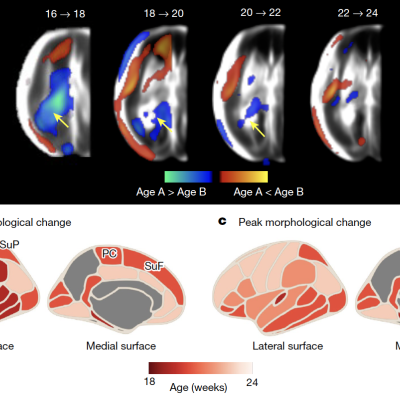
Publication of first normative digital atlas of human fetal brain
Publication
Namburete, A.I.L., Papież, B.W., Fernandes, M. et al. Normative spatiotemporal fetal brain maturation with satisfactory development at 2 years. Nature (2023). https://doi.org/10.1038/s41586-023-06630-3
The first digital atlas showing how the human brain develops in the womb has been published by a global research team led by the University of Oxford
A team of over 200 researchers around the world, involving multiple health and scientific institutions, led by the University of Oxford, has today published, in the journal Nature, the first digital atlas showing the dynamics of normative maturation of each hemisphere of the fetal brain between 14 and 31 weeks’ gestation - a critical period of human development.
The atlas was produced using over 2,500 3-dimensional ultrasound (3D US) brain scans that were acquired serially during pregnancy from 2,194 fetuses in the INTERGROWTH-21st Project, which is a large population-based study of healthy pregnant women living in eight diverse geographical regions of the world (including five in the Global South), whose children had satisfactory growth and neurodevelopment at 2 years of age.
The study is unique because, for the first time, an international dataset of 3D US scans, collected using standardised methods and equipment, has been analysed with advanced artificial intelligence (AI) and image processing tools to construct a map showing how the fetal brain matures as pregnancy advances.
Demonstrating remarkably similar patterns of fetal brain growth and development across diverse populations represents an important scientific advance in the field of neuroscience. The results are entirely consistent with previously reported findings, from the same INTERGROWTH-21st population, for fetal skeletal growth, newborn size and infant neurocognitive development. The results also highlight a vitally important public health message: a mother’s health, educational, nutritional and environmental needs must be met to ensure that her child’s body and brain develop healthily.
The findings add to the global impact of the INTERGROWTH-21st Project, which has previously produced international standards for fetal growth, newborn size and the postnatal growth of preterm babies, that are being widely adopted across the world for clinical and research purposes.
Professor Ana Namburete, the first author, whose research group developed the machine learning methods, said: “Using AI we enhanced the visibility of brain structures in the 3D US images, and generated an average depiction of the brain at each week of pregnancy during a critical period of development. Uniquely, our atlas captured patterns of brain growth from as early as 14 weeks’ gestation - filling a 6-week knowledge gap in our understanding of early fetal brain maturation. We also revealed significant asymmetries in brain maturation: for example, in the region associated with language development, which peaked at 20-26 weeks’ gestation and persisted thereafter without any differences between the sexes.”
Professor Stephen Kennedy, co-Principal Investigator of the INTERGROWTH-21st Project, who jointly led the study, said: “The atlas will help scientists answer complex biological questions about the fetal origins of cognitive function in childhood, such as how language is acquired. Using the atlas in combination with the soon to be published international standards describing the complementary growth of the fetal brain will be a valuable clinical tool in specialised, referral centres when brain development appears abnormal on ultrasound”.
Professor José Villar, co-Principal Investigator of the INTERGROWTH-21st Project, who jointly led the study, said: “This is the latest step in the systematic study of early human growth and development that confirms, using the most advanced research methodology applied to a large number of fetal brain scans, the similarities of growth and development of humans across the world when health, educational, nutritional and environmental needs are met: humans are very similar in all domains, including their brains, when conditions are adequate.”
The fetal brain atlas can be found freely available at: https://intergrowth21.com/research/brain-atlas-project
Within the University of Oxford, the project was led by the Nuffield Department of Women’s and Reproductive Health and the Department of Computer Science, supported by the Wellcome Centre for Integrative Neuroimaging, Department of Engineering Science, Big Data Institute, and Department of Psychiatry.
The INTERGROWTH-21st Project was supported by a grant from the Bill & Melinda Gates Foundation.
For further information and interview requests please contact: University of Oxford press office, news.office@admin.ox.ac.uk
Nuffield Department of Women's & Reproductive Health
The Nuffield Department of Women's & Reproductive Health at the University of Oxford encompasses multidisciplinary research across four overarching themes: Cancer, Global Health, Maternal & Fetal Health and Reproductive Medicine & Genetics. It focuses on genetic studies, the dissection of molecular, biochemical and cellular mechanisms underlying normal and aberrant reproductive tissue function, clinical studies in women’s health and pregnancy, and growth and development across the first 1000 days of life.
Oxford University’s Medical Sciences Division
Oxford University’s Medical Sciences Division is one of the largest biomedical research centres in Europe, with over 2,500 people involved in research and more than 2,800 students. The University is rated the best in the world for medicine and life sciences, and it is home to the UK’s top-ranked medical school. It has one of the largest clinical trial portfolios in the UK and great expertise in taking discoveries from the lab into the clinic. Partnerships with the local NHS Trusts enable patients to benefit from close links between medical research and health care delivery.





